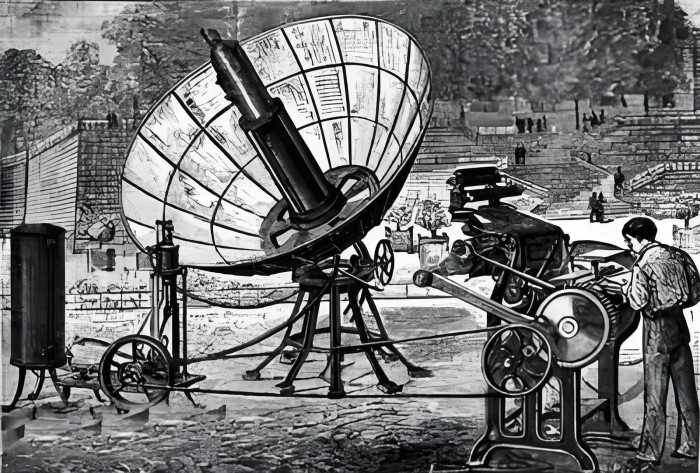Solar Energy History: Major Events & Inventions
Discovery of the Photovoltaic (PV) Effect
Solar energy's development commenced in 1839 when French physicist Alexander Edmond Becquerel (1820-1891) conducted research that led to the discovery of the "photovoltaic (PV) effect." While experimenting with a solid electrode in an electrolyte solution at the age of 19 in his father's laboratory, Becquerel observed the development of voltage when light struck the electrode. This phenomenon, later termed the Becquerel Effect, marked the foundational understanding of solar energy conversion.
In parallel, English electrical engineer Willoughby Smith (1828-1891) contributed to the advancement of solar technology by discovering the photoconductivity of selenium, a pivotal breakthrough that ultimately paved the way for the invention of photoelectric cells. Employed by the Gutta Percha Company in London from 1848, Smith focused on developing insulated iron and copper wires for underwater telegraph communication. Notably, in 1849, he oversaw the production and installation of 30 miles of underwater telegraph cable, linking Dover, England, to Calais, France.
In 1873, Smith devised a method for continuously testing underwater cables during installation. To construct his test circuit, he sought a semiconductor with high resistance and settled on selenium rods. Although selenium initially appeared suitable in laboratory settings, its performance proved inconsistent in practical applications. Through experimentation, Smith discovered that the conductivity of selenium rods significantly increased when exposed to sunlight. This revelation led to his publication of "Effect of Light on Selenium During the Passage of An Electric Current" in the February 1873 edition of Nature.
The exposure of selenium to sunlight generated an electrical current. Professor William Grylls Adams of King's College, England, and his student Richard Evans Day, demonstrated the direct conversion of solar energy into electricity without moving parts or heat during the late 1870s. Conducting various experiments with selenium, they placed bars of the material, previously used by Willoughby Smith, approximately an inch away from a lit candle.
Instantaneous reactions occurred on their measuring device's needle when the selenium was exposed to light, contrasting with the slow responses observed in thermo-electric experiments involving heat application or withdrawal. This ruled out the possibility of thermal electricity. Adams and Day deduced that light alone initiated a current in selenium, leading them to coin the term "photoelectric" to describe the phenomenon. While modern scientists refer to this discovery as the "photovoltaic effect," the significance of their findings remains a testament to the pioneering exploration of solar energy's potential.
The First Real Solar Module
In 1883, Charles Edgar Fritts, an American inventor, achieved a significant milestone by constructing the first functional solar module. Fritts coated a copper plate with selenium, overlaying it with an ultra-thin semi-transparent layer of gold leaf. He reported that this module produced a continuous and substantial current, responsive not only to sunlight but also to dim daylight and even candlelight. Fritts speculated on the potential of the "photoelectric plate" to compete with fossil fuel plants.
In materials like selenium, certain photons possess enough energy to dislodge loosely bound electrons from their atomic orbits. When wires were attached to the selenium bars, these liberated electrons flowed through them as electricity. However, the resulting modules had a meager electrical conversion efficiency of only 1%, primarily due to selenium's properties. Moreover, the high cost of selenium and gold rendered these early solar modules economically unviable.
Nevertheless, Fritts's innovation caught the attention of Werner von Siemens, a prominent German scientist whose technical acumen rivaled that of Thomas Edison. Impressed by the electricity output of Fritts's panels under light, Siemens presented one of them to the Royal Academy of Prussia. He proclaimed that Fritts's modules demonstrated "the direct conversion of the energy of light into electrical energy," marking a pivotal moment in the scientific exploration of solar power.
Einstein Explains the Photovoltaic Effect
In the late 1800s, Albert Einstein challenged prevailing scientific understanding by proposing a revolutionary idea about light in his seminal 1905 paper. Einstein introduced the concept of light quanta, which he termed photons, suggesting that light comprised packets of energy with varying power levels dependent on their wavelengths. According to his theory, shorter wavelengths carried more powerful photons compared to longer ones.

Einstein's groundbreaking insight, coupled with advancements in electron research during the late 19th and early 20th centuries, provided a scientific foundation for understanding photoelectricity. This theoretical framework elucidated how photons could dislodge electrons from their atomic orbits in semiconductor materials, potentially generating electricity when properly connected in a circuit. In 1913, William Coblentz obtained the first US Patent for a device to convert sunlight into electricity.
Despite these advancements, early attempts to harness photoelectricity fell short of expectations, with conversion efficiencies remaining at one percent or less throughout much of the twentieth century. Maria Telkes, a Hungarian-American scientist at MIT, expressed optimism about the potential of photovoltaic cells, believing that extensive research and development efforts could significantly enhance their efficiency and effectiveness in converting solar energy.
Bell Labs - First Practical Solar Cell
In April 1954, Bell Telephone Laboratories in Murray Hill, NJ, unveiled a groundbreaking innovation: the "solar cell," a modified silicon wafer capable of directly converting sunlight into electrical energy. Born out of transistor research, this invention marked a significant leap forward in renewable energy technology. Developed by Gerald L. Pearson, Daryl M. Chapin, and Calvin S. Fuller, the solar cell boasted an efficiency of just 6 percent, comparable to the performance of a typical gasoline engine at the time.
Operating on principles akin to those of transistors, the solar cell utilized a junction within a silicon crystal. This junction divided the crystal into two zones: one containing a slight impurity that generated an excess of movable electrons, and the other containing an impurity that absorbed electrons, creating movable "holes." When a photon of light struck the junction, it dislodged an electron from a crystal atom, creating a pair of loose electrons and holes. Due to the voltage difference across the junction, the electron and hole were pushed in opposite directions. When connected by an external circuit, this movement generated an electric current.
Bell scientists anticipated that with further engineering advancements, the efficiency of solar cells could reach 10 percent. They envisioned that an assembly of wafers covering a square yard could produce 50 watts of power, making solar cells valuable for applications like rural telephone systems. The New York Times even foresaw solar cells as a potential source of "limitless energy from the sun," heralding a new era of sustainable energy generation.
Solar Power Develops
In 1956, the first commercially available solar modules entered the market, but their cost remained prohibitive for the average consumer. Priced at $300 for a one-watt solar module, they were beyond the reach of most individuals. However, miniature solar cells began to find applications in toys and radios, marking the first instances of consumer products utilizing solar technology.

Throughout the late 1950s and early 1960s, solar panels powered satellites in both the US and Soviet space programs, where cost was not the primary concern. Instead, factors like size, efficiency, and durability drove design considerations. By the late 1960s, solar power had become standard for powering nearly all space satellites, with efficiencies reaching around 14 percent.
In the early 1970s, Dr. Elliot Berman, Chairman and Founder of the Solar Power Corporation, revolutionized the industry by designing a more affordable solar module. By utilizing a lower-grade silicon (rejects from semiconductor manufacturing) and manufacturing techniques akin to photographic film production, Berman reduced the cost from $100 per watt to approximately $20 per watt. This breakthrough was spurred by Exxon Corporation's funding, as their offshore oil rigs required solar panels to power warning lights atop the rigs. This development brought solar power from space applications to terrestrial use.
From the 1970s to the 1990s, solar cells found increasing application in remote areas for powering homes and in telecommunications infrastructure. Australia employed solar cells in microwave towers to bolster their communication capabilities, while desert regions utilized solar power to provide water where grid power was unavailable.
Today, solar cells are ubiquitous, with many utilities harnessing solar power during daylight hours and solar-powered cars and aircraft demonstrating the technology's versatility and potential. With the cost of solar cells now within reach for the average consumer, solar power presents an enticing and increasingly accessible renewable energy option.
Post a Comment:
You may also like:

